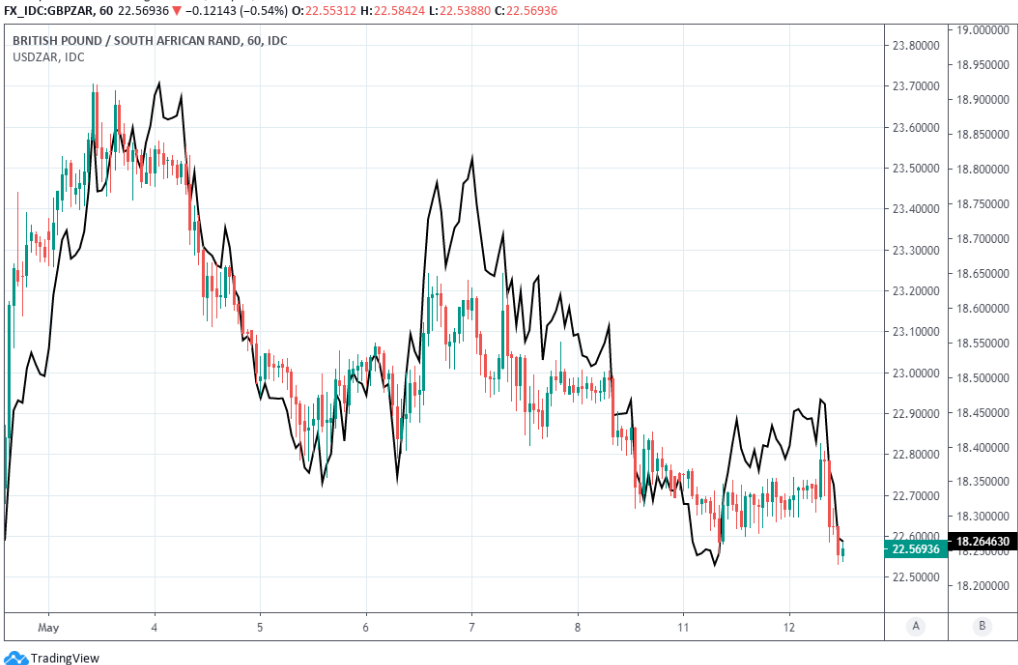South African Rand Recovery Vulnerable to Dollar Comeback and Risk Asset Reality Check
- Written by: James Skinner
-
- ZAR eyes two-month highs in May rebound off historic lows.
- But US-China tensions and virus reinfections are both risks.
- Bouts of risk aversion can wobble ZAR and slow the recovery.
- USD/ZAR to test 17.84 with outcome key to GBP/ZAR outlook.

Image © Adobe Images
- GBP/ZAR spot rate at time of publication: 22.56
- Bank transfer rates (indicative): 21.79-21.94
- FX specialist rates (indicative): 22.24-22.37 >> More information
The Rand was furthering a fortnight-long recovery on Tuesday and closing in on two-month highs as a result, although gains have left it vulnerable to any sudden comeback by the Dollar or reality check for risk assets that have been only temporarily encumbered by a series of emerging threats.
South Africa's Rand has turned higher since the dust settled on the country's belated exclusion from the FTSE World Government Bond Index at the end of April and the nascent recovery has now got the emerging market unit eyeing two-month highs against the Dollar and Pound. But the strength of a nearby support level for USD/ZAR and market reaction to the ebb and flow of developments in U.S.China relations, not to mention the global plod out of 'lockdown,' are all short-term risks to the recovery.
President Donald Trump said on Monday that he is "not happy" with China and that he has no interest in renegotiating January's 'phase one' trade deal after he was asked about press reports suggesting some in the ruling Chinese Communist Party would like to reopen talks. The comments came following speculation suggesting China's alleged lack of candour in response to the initial coronavirus outbreak could lead to new tariffs being imposed on the country's exports to the U.S., and amid fresh concerns about the durability of the pact that ended the trade war between the world's two largest economies.
"The US is basically asking China to double its prior purchases of services, agricultural, and manufactured goods by the end of 2021 and quadruple its buying of US energy over that time. Good luck with that. The final chapter of the agreement allows for either side to scrap the deal with six days notice. If he does, Trump likely raises tariffs and looks at other measures," says Bipan Rai, North American head of FX strategy at CIBC Capital Markets. "The inverse correlation between the USD and risk still holds, though there are signs of moderation. We remain strategic sellers of possible USD rallies."

Above: Pound-to-Rand rate shown at hourly intervals alongside USD/ZAR (black line).
The risk to global markets and the Rand is that January's phase one deal falls apart before it's even implemented and at a time when the global economy is on its knees, although it's not the only threat. Stock markets in the U.S. have retraced around 60% of their 2020 losses but at a time when the global economy is plodding only slowly toward a lockdown exit and as reinfection risks might be beginning to crystalise. The Rand and all 'risk currencies' including Sterling currently have a strong positive correlation with U.S. stocks.
Both China's Wuhan, the root of the pandemic, and South Korea have reported new coronavirus infections in recent days. Markets have taken note this week but could respond with heavier hands if new infections in once-clear places like Wuhan, which exited 'lockdown' last month and enjoyed weeks without any new infections, continue to rise. That could at worst lead some major economies to temper the pace at which they're exiting their own lockdown measures and frustrate the fledgling global economic recovery, with adverse consequences for stocks, commodities and risk currencies the world over.
"The ZAR is one of the biggest losers of the Corona crisis. We have adjusted our macro and exchange rate forecasts," says Elisabeth Andreae, an analyst at Commerzbank. "We see limited recovery potential for the rand in the medium term on the back of improving risk sentiment. By contrast, in view of the fragile economy, it is likely to suffer if risk aversion increases. Downside risks include an unfavourable course of the pandemic with further (major) waves of infection and a renewed flare-up of global trade conflicts."
Commerzbank downgraded forecasts for the Rand this week and now sees the USD/ZAR rate at 19 by the end of the second quarter and 18 by year-end, where before it had been seen falling to 17.0 before recovering to 16 in time to year-end. The Pound-to-Rand rate is tipped to rise from Tuesday's 22.56 to 23.19 by the end of June and 23.42 by year-end, where before it had been seen declining from 22.52 around the end of March through until year-end. The EUR/ZAR rate is seen rising from 19.75 Tuesday to 20.52 by year-end.
Above: USD/ZAR rate at weekly intervals, retreating from new record high in May after breaking series of Fib retracements.
"USD/ZAR holds firm despite drifting from the 18.35 threshold, teetering below 18.50, expressing lower levels of global distress than the likes of the Brazilian real, which remains the worst-performing EM currency this year. Tight ranges will probably persist as the world continues to contemplate the philosophical, humanitarian and economic consequences of covid-19, with lower levels of implied USD/ZAR vols suggesting lower levels of risk. Though not as hungry for South African assets as a week ago, offshore investors are still intrigued by the level of rand-denominated bond yields, especially as liquidity constraints have eased," says Nema Ramkhelawan-Bhana, an economist at Rand Merchant Bank. "There’s a natural ebb and flow in market trading, but much of the sentiment relies on the extent to which governments are willing to extend further support to see their economies through the worst."
Risks are rising for the Rand and forecasts falling as the currency approaches a key level against the Dollar, the resilience of which will help determine outcomes for other exchange rates like the Pound-Rand rate and EUR/ZAR rate. The USD/ZAR rate has been retreating fron 2020' new record highs and back toward the 17.84 level that marks the 100% Fibonacci retracement of the January 2016 downtrend since topping out around the turn of the month.
Whether or not 17.84 holds the next test to the downside could be key not only to the USD/ZAR outlook into mid-year but also the Pound-Rand rate too. After acting as a form of technical resistance barrier on the way up, the 17.84 level has provided support to USD/ZAR and stymied the downside in two of the six weeks since the end of March and if it does so again over the coming days then it might be enough to preserve the upside bias in the Pound-Rand rate.
The Pound-Rand rate has been turned back from the 78.6% Fibonacci retracement of its own 2016 downtrend repeatedly in recent weeks, ensuring that new record highs remain a distant prospect for Sterling, and was retreating on Monday and Tuesday after failing last week in its latest attempt to overcome 23.57. If the 17.84 USD/ZAR level holds this week then Sterling might continue to contemplate the grass on the north side of 23.57 but if that USD/ZAR level gives way to the downside either this week or in the weeks ahead, then it could also be curtains for the Pound-Rand rally.
Above: GBP/ZAR rate at weekly intervals, retreats from 71.8% Fibonacci retracement of 2016 downtrend.
